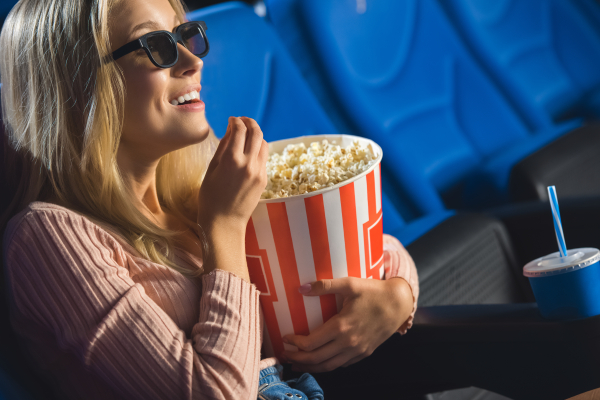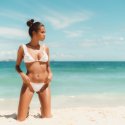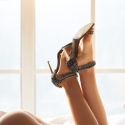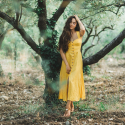The 11 Most Stylish Movies in Cinema History
 Throughout the history of cinema, numerous films have stood out for their impeccable style, featuring costumes crafted by the most renowned designers and costume artists like Hubert de Givenchy, Yves Saint Laurent, and Edith Head. From Scarlett O'Hara's elegant dresses to Annie Hall's quirky ties, Vogue UA has selected 11 films that are a must-watch for fashion inspiration.
Throughout the history of cinema, numerous films have stood out for their impeccable style, featuring costumes crafted by the most renowned designers and costume artists like Hubert de Givenchy, Yves Saint Laurent, and Edith Head. From Scarlett O'Hara's elegant dresses to Annie Hall's quirky ties, Vogue UA has selected 11 films that are a must-watch for fashion inspiration."Gone with the Wind" (1939)
The adaptation of Margaret Mitchell's classic American novel hit the screens in 1939, breaking nearly every Hollywood record. Some revisit this film for the dynamic pairing of Vivien Leigh and Clark Gable, while others are captivated by the meticulously designed costumes by Walter Plunkett for Vivien Leigh. Iconic ensembles include the cream-colored ruffled dress Scarlett O'Hara wears to the barbecue at the "Twelve Oaks" estate and her resourceful green velvet gown fashioned from plantation curtains post-war.
"Gilda" (1946)
Rita Hayworth's portrayal of Gilda epitomizes the femme fatale. In the film, she plays the wife of a cunning casino owner in Buenos Aires. With a costume budget exceeding $50,000, designer Jean Louis crafted exquisite lingerie from sheer lace, sequined dresses, and an outfit inspired by John Singer Sargent's "Portrait of Madame X," establishing a benchmark for on-screen glamour.
"Funny Face" (1957)
Every film starring Audrey Hepburn is a showcase of stellar fashion, with costumes created by the most prominent designers and artists of the time, from Hubert de Givenchy to Edith Head. Among Hepburn’s many iconic looks, her outfits in "Funny Face" stand out. Givenchy personally designed each of her costumes—over ten in total—perfectly complementing Paris’s landmarks, from the Louvre to the Tuileries Garden.
"La Dolce Vita" (1960)
No other Fellini film surpasses "La Dolce Vita" in showcasing fashion-forward aesthetics, partly inspired by the loose-fitting dresses of the era. The plot follows journalist Marcello Rubini (Marcello Mastroianni) as he trails a Hollywood star (Anita Ekberg) and a glamorous heiress (Yvonne Furneaux) around Rome. The film’s costumes are the epitome of Italian glamour, from Mastroianni’s oversized cufflinks to Ekberg’s strapless black dress, becoming timeless references.
"Belle de Jour" (1967)
Yves Saint Laurent designed the costumes for Catherine Deneuve in "Belle de Jour," where she plays Séverine Serizy, a bored housewife with a masochistic streak who becomes a daytime escort unbeknownst to her husband. Her wardrobe, consisting entirely of haute couture, dramatically shifts depending on whether Séverine feels submissive or dominant. One of Deneuve's best looks is in the final scene, where she appears in a demure dress with perfect hair, an image that remains relevant even after 50 years.
"Chinatown" (1974)
In this classic noir, Faye Dunaway plays Evelyn Mulwray, a femme fatale whose businessman husband is murdered amid the corrupt water industry during a 1930s drought. Even amidst police shootouts, Dunaway's character remains impeccably styled in tailored suits, elegant hairstyles, and signature red lipstick.
"Suspiria" (1977)
Dario Argento's horror film, released 40 years ago, still stands as one of the most stylish films in history. Set in an elite German dance academy, it follows a young American ballerina, Susie, who discovers the school is run by witches. The strict, sometimes buttoned-up dresses heighten the intensity of the film's scariest moments.
"Annie Hall" (1977)
No list of stylish films is complete without Woody Allen's "Annie Hall." This 1970s classic continues to inspire the fashion industry today, influencing everything from Kate Moss's personal style to Hedi Slimane's first collection for Saint Laurent. Annie Hall's wardrobe is a mix of menswear-inspired pieces and vests, accented with hats, round glasses, and patterned ties. Ralph Lauren, who provided the clothing for the film, significantly shaped Diane Keaton's iconic style.
"Romeo + Juliet" (1996)
Baz Luhrmann's film is celebrated for its distinctive style, with costumes vividly differentiating the two families. While the Montagues don bright Hawaiian shirts, worn Chuck Taylors, and neon hair, the Capulets appear in black leather and velvet. For the lead lovers, Luhrmann enlisted Miuccia Prada, who crafted simple yet striking outfits that made Romeo and Juliet stand out against their respective clans.
"Marie Antoinette" (2006)
For this film about the French queen, Sofia Coppola selected Oscar-winning Milena Canonero as the costume designer—a decision that paid off brilliantly. Canonero drew inspiration from the colors of traditional French desserts, directly using the palette of iconic Ladurée macarons. The meticulously crafted costumes were made in Roman ateliers using silks, taffeta, and authentic 18th-century lace. Even Marie Antoinette herself would likely have approved of these sumptuous designs.
"Phantom Thread" (2017)
This film is a striking collaboration between director Paul Thomas Anderson and actor Daniel Day-Lewis. "Phantom Thread" centers on the story of London couturier Reynolds Woodcock and is a tribute to the refined fashion of the 1950s. Costume designer Mark Bridges studied the clothing of designers from that era, such as Balenciaga and Norman Hartnell, and worked in the archives of the Victoria and Albert Museum in London. One of the film's standout pieces is a strapless wedding gown, crafted from three meters of rare 17th-century lace.








